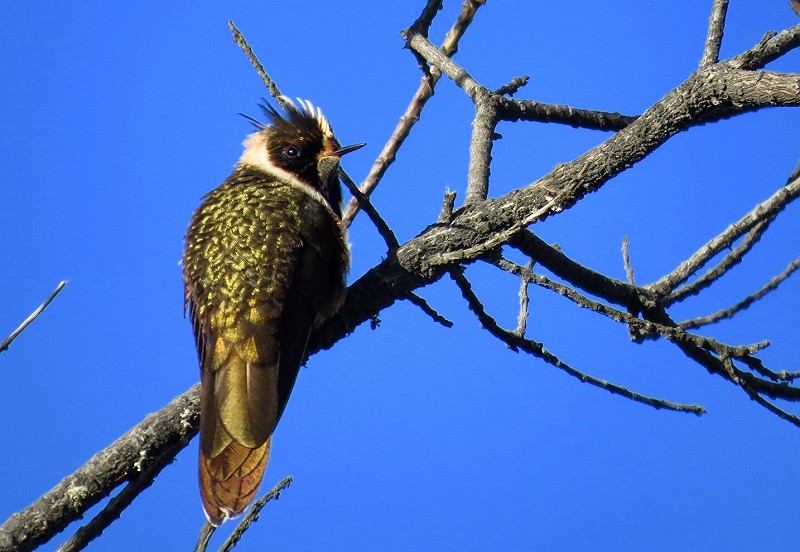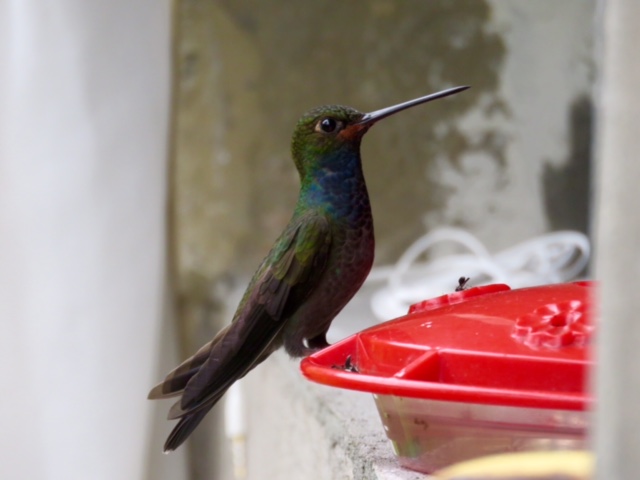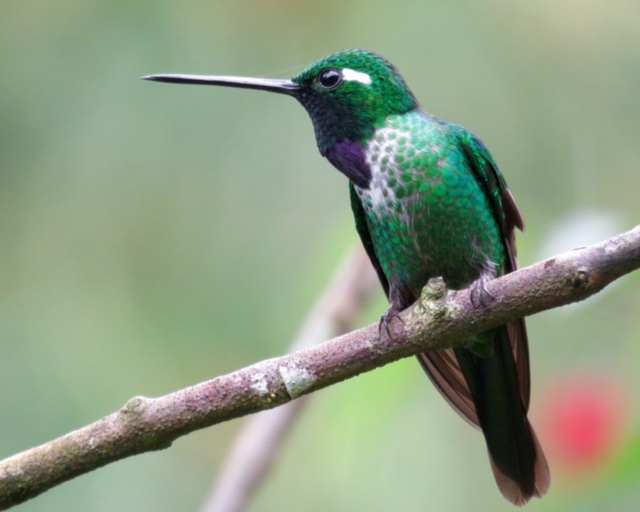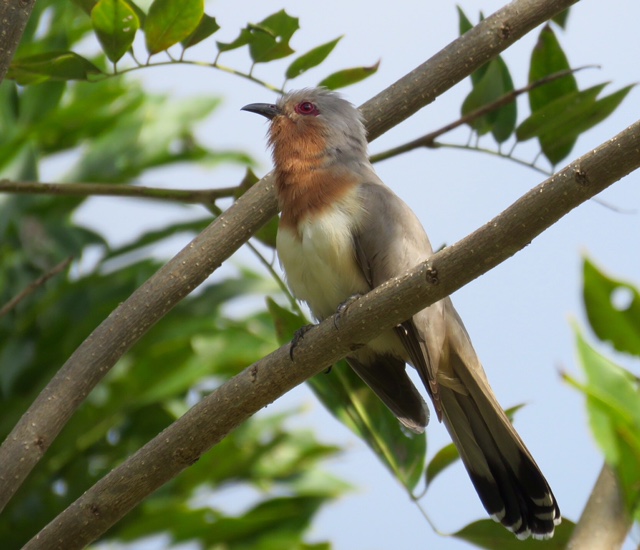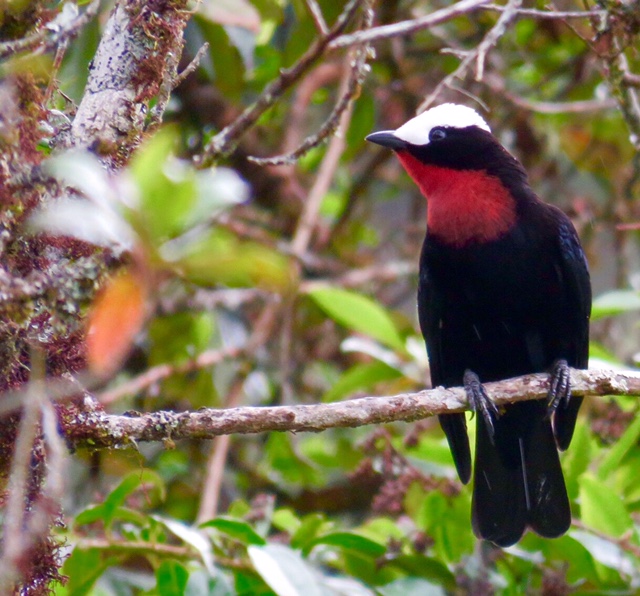October 16 - 20: Colombia (2)
25 October 2016 · Arjan Dwarshuis · 7333 × bekeken
PLEASE MAKE A DONATION NOW!
world.observation.org/arjan
www.arjandwarshuis.com/#biggestyear
October 16th AMAZING HUMMERS
At 4 AM we left Rio Claro and headed towards Parque Nacional los Nevados. This park protects one of the most venerable biomes in Colombia, the paramo. In this peculiar high altitude habitat, composed of bromeliads, bushes en grasses, one of the most spectacular hummingbirds in Colombia can be found, the Buffy Helmetcrest. Since we had rather poor views of the Green-bearded Helmetcrest we were especially keen on seeing this stunner frame-filling in the scope.
We were lucky, the weather was exceptional, sunny and zero wind en just 10 minutes after our arrival we had amazing views of a male Buffy Helmetcrest down to a few meters. For a couple of minutes we enjoyed this beauty, but then it was time to race down to reach the viewpoint for the endangered Rufous-fronted Parakeet before mist could settle over the mountains making it impossible to see this very rare bird. After a tense race against the clock Garry found no less than 10 parakeets just before the mist swallowed the very ridge they were foraging on: victory!
Further down again we visited the feeders at the hot springs of Termen del Reos. Although it looked tempting there was no time for a swim because here we could find the most beautiful hummingbird of them all, the Rainbow-bearded Thornbill. Finding this bird is luckily very easy since it regularly comes in to feed. What an amazing looking bird. Well, just look at the picture that Garry took and you can understand that we were utterly excited when we laid eyed on this dazzling hummer!
From here it was a long drive to the town of Apia, from where we switched to a 4x4 and drove up to a small reserve. Here we looked for the highly localized Yellow-headed Manakin, but unfortunately we only heard this mega.
After this dip we drove to the Birding Walhalla of Montezuma Road, where we arrived around 9 PM.
October 17th BANGSIAS!
Today we were joined by the keen Guatemalian birdwatcher John Cahill, a 20-year-old fanatic birder who will guide me in Guatemala a month from now. Great to have an extra pair of eyes and great to already plan my Guatemala trip with John.
Montezuma basically is a track that runs through continuous cloud forest ranging from 1200 - 2600 meters. In this forest some mega birds can be found including the critically endangered Munchique Wood-wren (at the top) and two beautiful and rare tanagers belonging to the Bangsia genus, namely Gold-ringed and Black-and-gold Tanager.
We started at a viewpoint below the top and within the first hour after dawn we found several stunning Gold-ringed Tanagers, a heard only Scaled Fruiteater, Star-chested Treerunner and several jaw-dropping Chestnut-breasted Chlorophonias.
As we walked down we got one star bird after another. This was due to the fact that the weather was just perfect, it started sunny and clear and gradually it got overcast with now and then a light drizzle: ideal conditions for cloudforest birding. Highlights in the morning hours where Beautiful Jay, Indigo Flowerpiercer, Black Solitaire, Cloud Forest Pygmy-owl and a cooperative singing Bicolored Antvireo. The latter being a super localized species that is only reliably found here.
The afternoon was a lot quieter, but still new birds were added to my ever growing year list. About 250 birds to go for the new record!
October 18th HARD RAIN, HARD BIRDS
This morning we left Montezuma Lodge at 5 AM and drove up to the pass, one of the only accessible – and well protected – sites for the critically endangered Munchique Wood-wren. This recently discovered species has a tiny range and clings on at four tiny pockets of stunted elfin forest in the Western Andes of Colombia.
Things didn’t start well, rain was pouring down and because so conditions for birding were horrendous. We walked up and down the track for two hours, but only heard the wren. The endangered Chestnut-bellied Flowerpiercer proved equally elusive.
Then we found a short window to operate! The rain stopped for just 15 minutes and bird activity commenced. We quickly found the wren which gave stupendous views and not long thereafter we found two Chestnut-bellied Flowerpiercers singing next to the road, mission accomplished.
We drove down hoping to dodge the rain, but lower down the weather was equally bad, resulting in three heard-only Choco Vireos that were impossible to see due to the fact that the very trees they were feeding in were covered in mist.
In the afternoon we made a radical decision. We had seen most of our targets so we packed our bags and were ready to leave, but while having lunch we decided that if we had a really good afternoon a couple of hours more at Montezuma wouldn’t hurt. So we unloaded our bags and started birding once again.
We had made an excellent choice since the rain stopped and because of that birds were quite active for this normally unproductive time of day. I was playing my Southamerican nemesis bird Lanceolated Monklet at every bend in the road as I did many times before this year, but suddenly one started calling back! We tried hard to localize this notoriously immobile bird, but after two tense minutes I located the bird. Yes! Finally I’d found my Monklet!
After dinner we said goodbye to Montezuma and headed to La Virginia, halfway between Montezuma and Jardin.
October 19th REMCO AND HIS WHITE-CAPPED TANAGER
We started our day birding the open countryside near La Virginia hoping to find the Dwarf Cuckoo. This localized species is most easily found in Colombia and given the fact that cuckoos are just cool birds, we were keen on our target.
The cuckoo proved hard, for hours we birded the open countryside, but no cuckoos. Meanwhile it got hotter and hotter and there was little shade to cool down.
It was Remco who relieved us from this burden when he found a cuckoo from the moving car, perching right next to the road! We watched a pair of these awesome birds for a while as they were hunting caterpillars just meters away. Fantastic.
Next we headed to Jardin. We arrived around 2 PM at a patch of cloud forest where Jose had seen Remco’s most wanted Southamerican bird – White-capped Tanager – several times before. We played the call of the bird and within seconds we got a response. Remco started jumping around excitedly – he is surprisingly nimble for a guy his size. And he got his Tanager, better than he could have dreamed. For half an hour we watched eight birds calling just meters away. Simply amazing! Best of course was that now we didn’t have to hear Remco wining about White-capped Tanager every half an hour ;-) Congratulations my fried, you’ve earned this bird!
We finished the day with one of the most enigmatic Colombian birds, the endangered Yellow-eared Parrot. This beautiful bird balanced on the brink of extinction for a long time, but due to the efforts of ProAves the species has made a remarkable recovery. We saw a couple of dozens of these beautiful parrots flying and perching on the very palm trees they are so depended on for breeding and roosting. Awesome.
October 20th GERJON AND HIS COCK-OF-THE-ROCKS
Gerjon’s most wanted bird of the trip was the Andean Cock-of-the-Rock and since there was a lek of these beautiful birds right at the edge of Jardin we decided on starting our day with making Gerjon’s dreams come true. At dawn Jose took us to the lek and immediately we found ourselves surrounded by five male Andean Cock-of-the-Rocks. Great to see my travel companion go completely nuts like Camilla did one month ago in Peru.
After that spectacle it was business as usual with chasing rarities. The most important bird of the day was the endemic and endangered Red-bellied Crackle which we – thanks to Jose’s local knowledge – found with relative ease. Other targets in the cloud forest above Jardin were all difficult, but we did manage to find a few, including the yet undescribed (sub)species of Rufous Antpitta.
Next we commenced the long drive to Rio Claro, but we had a planned stop to look for the recently described, very local and in all likelihood critically endangered endemic Antioquia Wren. We arrived at the site at 3:30 PM thinking that we had ample time to find this bird which is supposed to be locally common at this site. You see, almost all the habitat in the Cauca valley has been destroyed and the wren – that was once more widespread – now survives in just a few patches of gallery forest along steep gullies. Here the wrens should still be easy to find.
We were proven wrong. At 5:15 PM we still hadn’t seen or heard a single wren and we – with a strong emphasis on ME – started to worry. By 5:30 PM we were quickly losing light and by that time I found myself in a state of complete panic. In an ultimate attempt to connect with this enigmatic species we raced back up with our van to one of the higher forest patches. We jumped out and Jose played the tape. Tension on everyone’s face… Bam! An Antioquia Wren sang back! A tense 10 minutes followed wherein we eventually all managed to see the wren. Garry made a legendary sound recording of these 10 minutes which he will post on dutchbirding.nl.
Arjan Dwarshuis
PLEASE MAKE A DONATION NOW!
world.observation.org/arjan
www.arjandwarshuis.com/#biggestyear
Discussie
Jurgen van der Meer
·
27 October 2016 16:45
nog maar een paar man, proficiat!
Gebruikers van het forum gaan akkoord met de forumregels.


